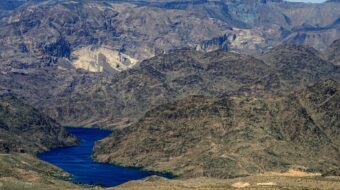
MEDFORD, Ore. – There is a certain quality to the air in the Cascades in Oregon that defies attempts to put it into words.
To know it, you have to experience its freshness and goodness first-hand, as on a sparkling day in high summer running the rapids on the Rogue River.
The Rogue is a handsome river, happily streaming along, fed by the 10 thousand streams that issue from the mountains and volcanoes everywhere around it.
It sits in the area of Oregon known affectionately as the Big Squeegee, because the Cascade Mountains squeegee the moisture out of the air and dump it into the Rogue, in the process unfortunately turning eastern Oregon into a desert by casting a large rain shadow over it.
The Big Squeegee of the Cascades is a paradise of a sort. The original settlers who drove their wagons along the Oregon Trail certainly thought so.
Their descendants live here still, on huge vineyards and ranches. In their ranch houses, they still have the leather-bound journals of their great-great-grandparents, with entries such as, “Chased a mtn lion till I lost him in the hills, I left for dead two injuns [sic] awalking through the meadows, the which took two good bullets to shoot, can’t wait till I get that fine-looking filly inter the pasture, I swear she is a fine horse to give to my daughter.”
That’s how the West was won hereabouts. You just cut out a couple hundred acres of land and if the First People objected the least bit, you went on an “injun-shoot” and shot them and that’s how you got your land.
Everywhere you look in the Rogue Valley are bees, peaches, pears, grapes, and dairy cows. This is the land of Umqua milk and ice cream – the last a match for the very best ice cream in the world – and Tilamook cheese, as good as Wisconsin’s. The soil is volcanic and fertile, the climate is temperate and the rainfall is plentiful. It is verdant and green. If you push a stick in the ground, a tree will grow.
And this is where the frackers want to put a pipeline, to feed a liquified natural gas (LNG) port, which will require a 4.2 megawatt, coal-fired power plant feeding a frack-gas liquidizing factory at the port.
The United States is awash in frack-gas, from the ruptured innards of Colorado, Utah and Arizona, to the point where production is dangerously close to overproduction. In other words, close to the point where energy prices for the consumer might drop. But of course, the market being a generalized-monopoly market, a drop in prices will not and cannot be allowed to happen. Instead, another market must be found for the gas.
An Asian market. And the contracts need to be signed and locked in before Russia can underbid and outperform the United States.
Thus the “‘need” for another LNG terminal on the West Coast. Coos Bay, more or less in the middle of the southern Oregon coast, has been picked. Why the frack-gas cannot be left in the ground, since the United States does not need it, so as not to pose a threat to the climate, is a question that is not asked. To even pose such a question would not accord with the logic of capitalism. Growth without regard to consequence is the logic of capital, and cancer cells.
As for the coast of Oregon where Coos Bay is located, it is everything you would expect from a novel – a wind-tossed shoreline, the abode of whales, more wild than tame, the route of scenic trains. It is not untouched: the salmon are mostly gone, as are the beaver and the wild things, hunted since the first Native Americans paddled down from Beringia and Alaska. But it is a place of natural beauty. It deserves to not to be spoiled.
LNG, liquified natural gas, is bitterly cold and will kill at the touch. It is heavier than air but will float on water, even while freezing the water below it. A single spark will set it off. In fact, exactly that happened in March of this year, at an LNG facility in Washington, along the Columbia River. Authorities were so frightened of the the consequences that they evacuated all residents within two miles of the facility.
They had good reason to. There is a history of horrific LNG explosions. The first such explosion was in 1944 in Cleveland, Ohio. The liquid got loose from an apparently well-designed tank and ran into the storm sewers. No one was even aware that a leak had occurred, much less that it went beneath and beside homes and businesses. The explosive gas suddenly erupted in a giant fireball that nearly vaporized 130 people and required a day to be put out by every fire unit in the city of Cleveland. Industry reports afterward stress that the causes were found and remedied, and perhaps they were, in terms of engineering. But strangely enough, industry sources never said who should be arrested and put on trial for the negligent homicide of 130 innocent people.
Who could possibly imagine that a liquid might run down storm sewers?
It is against this background that a local movement has grown up here to oppose the pipeline, oppose the LNG terminal and oppose the coal-fired power plant that would power the facility.
One such opposition march occurred on Sept. 5, 2015. The day sparkled with color and sunshine, a 72-degree, clear, bright, Oregon day by the Rogue River. Music was provided by Off the Wall Music – a country folk group. Hikers from Hike the Pike have been following the line of the proposed route of the pipeline through Oregon. That day they floated on rafts down the river to a park in Shady Grove, where they were met by a picnic and a demonstration. The route they follow marks an approximately 230-mile extension from an existing pipeline through Oregon, which, if completed, would run from the Rockies to Coos Bay. The Rogue River is normally ice-cold from the melting of the snowpack, but this year, with no snow pack due to the drought here, the water was warmer. No fools they, the hikers climbed out of the water and headed straight for the food to a round of applause.
Several people spoke at the meeting. One local man said not to trust the LNG people when they promised jobs. He had talked to the surveyors for the project and not one was an Oregon surveyor. They were all hired out of state. Indeed, most pipelines are built like the Alaska pipeline; they are built by out-of-state companies who bring in out-of-state specialists who direct-deposit their paychecks back in their home states. They have no interest in spending the money in-state, unless they are buying what the company does not supply – liquor, drugs and prostitutes.
Another man stood to point out that renewable energy, rather than fossil-fuel energy, creates more jobs and that they are local and permanent. The jobs promises by fossil-fuels industries are rarely kept, he said. They are the “bait” in a “bait and switch” scheme.
A woman said she was informed by the company that the pipeline running through her property would be done on a schedule of 24 hours a day, for at least three weeks, and that during construction, the noise would be “totally deafening.”
She replied that she didn’t have the money to go to a hotel for three weeks. The company wasn’t interested. If she didn’t sign on the dotted line, the state would institute eminent domain proceedings on her property, she was told.
She found out later that lower safety standards apply to almost the whole pipeline, including the part 120 feet from her house, since it is crossing rural property practically its entire length.
A spokesperson from SOCAN.info based in Ashland (the “Buddhist Belt” of southern Oregon) said that if the terminal were built, it would be the biggest greenhouse gas emitter in Oregon after 2020. If the U.S. is trying to cut back on greenhouse gas, then why is it trying to increase its exports of it?
For the project, the Federal Energy Regulatory Commission issued a draft environmental impact report. It was found by the State of Oregon and by federal agencies, also, to be so poorly done that it was incompetent. For one thing, it covered only the pipeline itself, leaving out the impacts of the fracking, transporting and liquefying of the gas. The Portland newspaper the Oregonian labeled it so badly thought out as to be “incoherent.”
As the day came to an end, a short demonstration marched to a bridge over the Rogue and hung a banner. The hikers will continue their journey to Coos Bay.
Photo: J. E. Johnson











